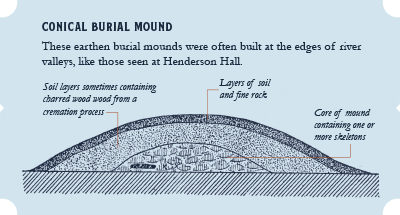There are three Early Peoples mounds located on the Henderson Hall property. These mounds were built by the Adena Indians about 2,000 years ago. These Indians were also called mound builders. The mounds contain skeletal remains and other artifacts such as utensils and spearheads. Little is known of these Native Americans except for what has been found in the mounds. The mounds at Henderson Hall have never been dug and will continue to hold the mystery of a civilization that once inhabited the area surrounding Henderson Hall.
West Virginia was home to many generations of Native Americans long before European settlers arrived. Early Woodland peoples such as the Adena built mounds over the remains of chiefs or other people of high social standing.






The Adena lived in circular houses made of wickerwork and bark that were joined to large wooden beams to form a conical-shaped roof. These structures ranged from 15 to 45 feet in diameter and may have been used for both domestic and ceremonial purposes.
Artifacts found at Henderson Hall
Several Adena flint tips and arrowhead points have been found over the years near the burial mounds at the Henderson Hall plantation. Many of these can be seen on display in Henderson Hall. In many mounds, individuals were laid to rest with a variety of grave goods such as flint tools, beads, pipes, and mica and copper ornaments.
